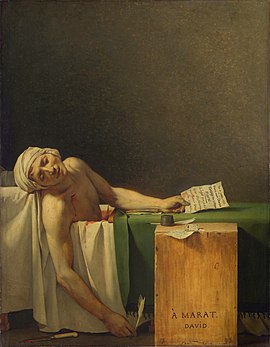| The Death of Marat | |
|---|---|
| French: La Mort de Marat | |
 | |
| Artist | Jacques-Louis David |
| Year | 1793 |
| Medium | Oil on canvas |
| Movement | Neoclassicism |
| Dimensions | 162 cm × 128 cm (64 in × 50 in) |
| Location | Royal Museums of Fine Arts of Belgium |
The Death of Marat (French: La Mort de Marat or Marat Assassiné) is a 1793 painting by Jacques-Louis David depicting the artist's friend and murdered French revolutionary leader, Jean-Paul Marat.[1] One of the most famous images from the era of the French Revolution, it was painted when David was the leading French Neoclassical painter, a Montagnard, and a member of the revolutionary Committee of General Security. Created in the months after Marat's death, the painting shows Marat lying dead in his bath after his assassination by Charlotte Corday on 13 July 1793.[2] Art historian T. J. Clark called David's painting the first modernist work for "the way it took the stuff of politics as its material, and did not transmute it".[3]
The painting is in the collection of the Royal Museum of Fine Arts of Belgium. A replica, created by the artist's studio, is on display at the Louvre.[4]
Jean-Paul Marat (24 May 1743 – 13 July 1793) was one of the leaders of the Montagnards, a radical faction active during the French Revolution from the Reign of Terror to the Thermidorian Reaction. Marat was stabbed to death by Charlotte Corday, a Girondin and political enemy of Marat who blamed Marat for the September Massacre. Corday gained entrance to Marat's dwelling promising either to divulge the names of traitors of the Revolution or to plead for the lives of her Girondin acquaintances (historical records disagree on her ostensible reason for meeting with Marat).[5]
Marat suffered from a skin condition that caused him to spend much of his time in his bathtub; he would often work there. Corday fatally stabbed Marat, but she did not attempt to flee. She was later tried and executed for the murder.[6]
When he was murdered, Marat was correcting a proof of his newspaper L'Ami du peuple. The blood stained page is preserved. In the painting, the note Marat is holding is not an actual quotation of Corday, but a fictional expression based on what Corday might have said.[7]

The leading French painter of his generation, David was a prominent Montagnard and a Jacobin, aligned with Marat and Maximilian Robespierre. [citation needed] As a deputy of the museum section at the National Convention, David voted for the death of French king Louis XVI and served on the Committee of General Security, where he actively participated in sentencings and imprisonment, eventually presiding over the "section des interrogatoires".[citation needed] David was also on the Committee of Public Instruction.[8]

The Death of Marat has often been compared to Michelangelo's Pietà, a major similarity being the elongated arm hanging down in both works.[citation needed] David admired Caravaggio's works, especially Entombment of Christ, which mirrors The Death of Marat's drama and light.[citation needed]
David sought to transfer the sacred qualities long associated with the monarchy and the Catholic Church to the new French Republic. He painted Marat, martyr of the Revolution, in a style reminiscent of a Christian martyr, with the face and body bathed in a soft, glowing light.[9]


Several copies of the painting were made by David's pupils in 1793–1794, when the image was a popular symbol of martyrdom amid the Reign of Terror. [citation needed] From 1795 to David's death, the painting languished in obscurity. During David's exile in Belgium, it was hidden, somewhere in France, by Antoine Gros, David's most famous pupil. [citation needed]
There was renewed interest in the painting after Pierre-Joseph Proudhon and Charles Baudelaire praised the work after seeing it at the Bazar Bonne-Nouvelle in 1845.[10] Nineteenth-century paintings inspired by David's work include Paul Jacques Aimé Baudry's Charlotte Corday. In the 20th century, David's painting inspired artists such as Pablo Picasso and Edvard Munch, poets (Alessandro Mozzambani) and writers (Peter Weiss' play Marat/Sade).[citation needed] Brazilian artist Vik Muniz created a version composed of contents from a city landfill as part of his "Pictures of Garbage" series.[11]
The letter that appears in the painting, with bloodstains and bath water marks still visible, has survived and was owned by Robert Lindsay, 29th Earl of Crawford.[12]